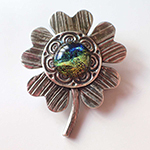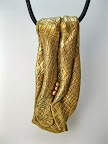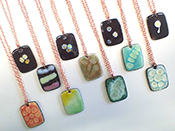Is it true that silver…?
This page contains a simple collection of topics that often come up in the discussion of jewelry and other small adornments.
On the “aging” or “tarnishing” of silver:
All silver will change color over time, but…
Fine silver (.999 or .999 fs or just “fs”) does this slowly, usually turning a rather golden color before it goes through a range of browns and then turns black.
Sterling silver (.925) does this more quickly because of the copper in it, usually going through a range of gray colors before it reaches black.
Argentium sterling (.9xx as or just “as”) is sort of between those two. It is marketed as “tarnish resistant” because the process goes more slowly than traditional sterling (i.e. at a rate comparable to fine silver), although in my experience the color range is more in the grays (i.e., comparable to regular sterling).
There are a number of ways to “polish” the silver back to that silver-colored shine. I’m not planning to go into that; the one thing I will say, though, is that if your piece has some nice patina color on it, you should know that (a) the color is only temporary (i.e., enjoy it while you can); (b) storing the piece with a tarnish-resisting product can help slow the darkening that will occur over time (but cannot totally prevent that); and (c) a good polish will remove the color at any stage of its development.
On “allergies” to silver (or other “precious” metals):
If you appear to be allergic to silver (or gold or platinum), please consider these alternative scenarioss:
1. ALL sterling silver contains materials other than silver. You are far more likely to be reacting to one or more of those than to the silver itself. Consider trying a piece of fine silver jewelry instead. (The same thing goes for gold: 24K gold is pure gold, as .999 silver is pure silver. If you react to gold and the number before the K is less than 24 (e.g., 18K, which is only 75% pure gold), then you may well be reacting to the other components of the piece, not the gold itself.)
2. Fine silver (and 24K gold) should contain only that within the piece, but there may well be other materials (i.e., chemicals) applied to the surface. You may be able to see them (e.g., colored patinas, resins, etc.). But in many cases you may not (e.g., polishing compounds), and many of these chemicals are far more likely to cause a reaction than is any pure precious metal. Talk with your jeweler about this: s/he may well be able to create a piece for you that either uses no other chemicals, or at least uses instead only a few household products that you already use without reaction. (For example, I usually finish off a piece by rubbing it with a treated polishing cloth just because that’s easiest for me. But, if a customer asks me not to do so, I can clean it up with simple baking soda instead—that is a little messier at my end, but I’m happy to do it that way if it really matters to you.)

 Artsmiths of Pittsburgh
Artsmiths of Pittsburgh Hoyt Center for the Arts, New Castle, PA
Hoyt Center for the Arts, New Castle, PA Portage Hill Gallery, Westfield, NY
Portage Hill Gallery, Westfield, NY _Open Houses in my Studio
_Open Houses in my Studio _Or…contact me about hosting a private party!
_Or…contact me about hosting a private party!